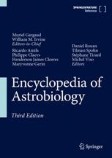Search
Search Results
-

-
The effects of magnetic field, obliquity, and positively charged dust on dust-ion-acoustic subsonic solitary waves
In this article, we investigate a magnetized plasma system consisting of cold positive inertial ions, Maxwellian distributed electrons, and...

-
The large obliquity of Saturn explained by the fast migration of Titan
The obliquity of a planet is the tilt between its equator and its orbital plane. Giant planets are expected to form with near-zero obliquities
1 ,2 ....
-
The Change of Period and Obliquity Angle of Pulsar under Braking of Magnetic Dipolar Radiation and Magnetic Decay
AbstractThe change of pulsar period and inclination angle under the braking of magnetic radiation and magnetic decay is studied. The system of...
-

-
Science orbit design with a quasi-frozen beta angle: effects of body obliquity on J2-perturbed dynamics
The beta angle, an angle formed by the sunlight and a spacecraft orbital plane, is an important parameter for science orbit design of orbiter...

-
Analytical investigation about long-lifetime science orbits around Galilean moons
It is desirable to design low-altitude and near-polar science orbits for missions to Galilean moons. However, the long-term perturbation from a...

-
Polarization-insensitive and wide-angle MXene-TiN-based wideband absorber operating in the visible and near-infrared regime
This study proposes a simple design of a wideband metamaterial absorber (MMA) that functions in the visible and near-infrared range. The proposed...

-
Geological Record of Water and Wind Processes on Mars as Observed by the Mars Express High Resolution Stereo Camera
This review paper summarizes the observations and results of the Mars Express Mission and its application in the analysis of geological processes and...

-
Mutual Changes in Temperature and Aerosol Content in the Atmosphere Based on Antarctic Ice Core Data for the Last 800 000 Years
AbstractA comparative analysis of mutual changes in temperature and aerosol content in the atmosphere was carried out based on Antarctic ice core...

-
Obliquity-driven sculpting of exoplanetary systems
NASA’s Kepler mission revealed that ~30% of Solar-type stars harbour planets with sizes between that of Earth and Neptune on nearly circular and...

-
Buried palaeo-polygonal terrain detected underneath Utopia Planitia on Mars by the Zhurong radar
As the largest basin on Mars, Utopia Planitia has both experienced and recorded variations of the Martian palaeoclimate. Layered subsurface...

-
Measured spin–orbit alignment of ultra-short-period super-Earth 55 Cancri e
A planet’s orbital alignment places important constraints on how a planet formed and consequently evolved. The dominant formation pathway of...

-
Petal failure models of thin aluminum alloy plate penetrated by conical projectile nose
AbstractThe process of the penetration of thin aluminum alloy plates which are widely used in satellites by conical projectile nose is studied in...

-
Determination of X-ray pulsar geometry with IXPE polarimetry
Using observations of X-ray pulsar Hercules X-1 by the Imaging X-ray Polarimetry Explorer we report a highly significant (>17 σ ) detection of the...

-
Properties of pulsar subpulse drifting in different profile components
We investigate the emission properties of the pulsars that exhibit different drifting subpulses in different pulse profile components based on the...

-
10 Ancient and Recent Lakes on Mars
The search for life on Mars is guided by our knowledge of the environments occupied by terrestrial biota. Geology and atmospheric models converge to...
-
Bošković’s Method for Determining the Axis and Rate of Solar Rotation by Observing Sunspots in 1777
In 1777 Ruđer Bošković observed sunspots, determined their positions and the solar rotation elements by his own methods briefly described here. We...

-
Long-Term Evolution of the Saturnian System
Here we present the current state of knowledge on the long-term evolution of Saturn’s moon system due to tides within Saturn. First we provide some...

-
On the rotational motion of NEAs during close encounters with the Earth
During their lifetime, the Near-Earth Asteroids (NEAs) suffer numerous close encounters (CE) with Earth, Mars and Venus. It has been demonstrated...
